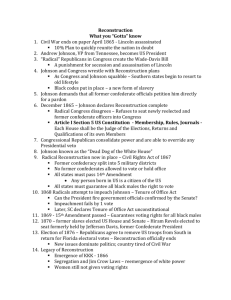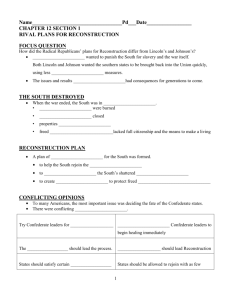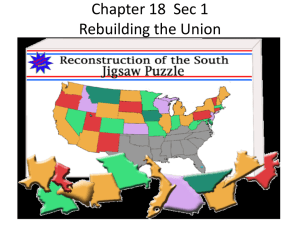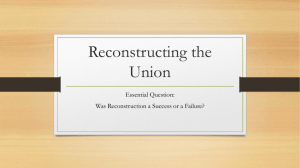Reconstruction
advertisement
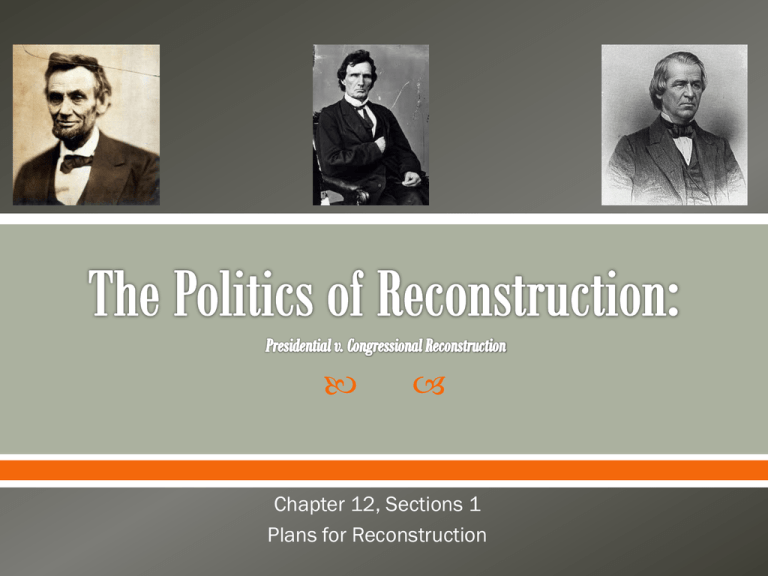
Chapter 12, Sections 1 Plans for Reconstruction Reconstruction was the period between 1865 to 1877 in which the nation began to rebuild as well as readmit the Confederate states. Lincoln’s plan was known as the Proclamation of Amnesty & Reconstruction (a.k.a the 10% Plan). *Pardons rebelling states if 10% of voting population swore allegiance to the Union. *High-ranking Confederate officials and those convicted of war crimes were excluded. Radical Republicans, led by Thaddeus Stevens, disagreed with Lincoln’s lenient policy and sought to punish the Southern slaveholders while granting African-Americans full citizenship and suffrage; a radical idea at the time. Radical’s respond to the Ten-Percent Plan with the Wade-Davis Bill, which would place the control of Reconstruction in the hands of Congress. Lincoln “pocket vetoes” the bill, simply ignoring the bill until Congress adjourned prior to the ten day allowance period. Lincoln’s assassination made his V.P. Andrew Johnson president in 1865. Johnson continued many of Lincoln’s policies and told Confederate states they needed to meet four criteria to be readmitted. 1) 2) 3) 4) Withdraw their secession Swear allegiance to the Union Annul Confederate war debts Ratify the 13th Amendment- ending slavery Radical Republicans disagreed with Johnson’s plan because it failed to address the issue of freed slaves. Land, voting rights, and protection under the law … Why was this seen as a problem? Many Southern states liked Johnson’s menial terms and lack of granting blacks suffrage. Some states like Mississippi did not fully comply (13th amendment) and still gained readmission. Southern members who had sat in the Confederate Congress, held cabinet seats for Davis, and fought against Union generals were allowed to sit in Congress. Radical’s and African-American’s were infuriated. Congress pushed back against Johnson’s plan with two acts: The Freedmen’s Bureau and The Civil Rights Act of 1866. The Freedmen’s Bureau helped freed slaves and poor whites in the South with clothes, food, and setting up hospitals, schools, and training institutes. The Civil Rights Act of 1866 gave blacks citizenship and forbade states from passing discriminatory laws, known as black codes. Johnson shocked the nation with his veto of these two acts, and put both Moderate and Radical Republicans against him. In mid-1866, these Republican’s joined forces to override the presidential veto and then drafted the 14th Amendment which would grant citizenship to all people born or naturalized in the U.S. Johnson stopped the amendment from passing by advising Southern states not to ratify since it was so harsh against former Confederate leaders. The struggle between Johnson and the Congress came to a head after his veto on the Reconstruction Act of 1867 was overrode by Congress. When the Tenure of Office Act was violated by Johnson, who believed it to be unconstitutional, the Congress had what they needed to try to impeach Johnson. The vote was one shy of a 2/3rds majority (35-19), and Johnson narrowly escaped an inglorious end to his presidency. The Presidential Election of 1868 was an easy victory for the Republican candidate, Ulysses S. Grant, mainly due to the African-American vote which was overwhelming. Radicals introduced the 15th Amendment. This would restrict any state or person from keeping people from voting based on race, color, or previous condition of servitude. Many Southern states still refused to enforce the 14th & 15th amendments, and some even resorted to violence in keeping blacks from the polls. Both Lincoln and Johnson worked to reunite the North and South, but many of their plans were seen as weak and ineffective. Congress, for the first time in history, overrode a president and took charge of reconstruction. President Johnson was the 1st president to face an impeachment trial. The tensions of the Reconstruction era would aid in its failing. HW: SPNotes 12.2 (p.383-392)

